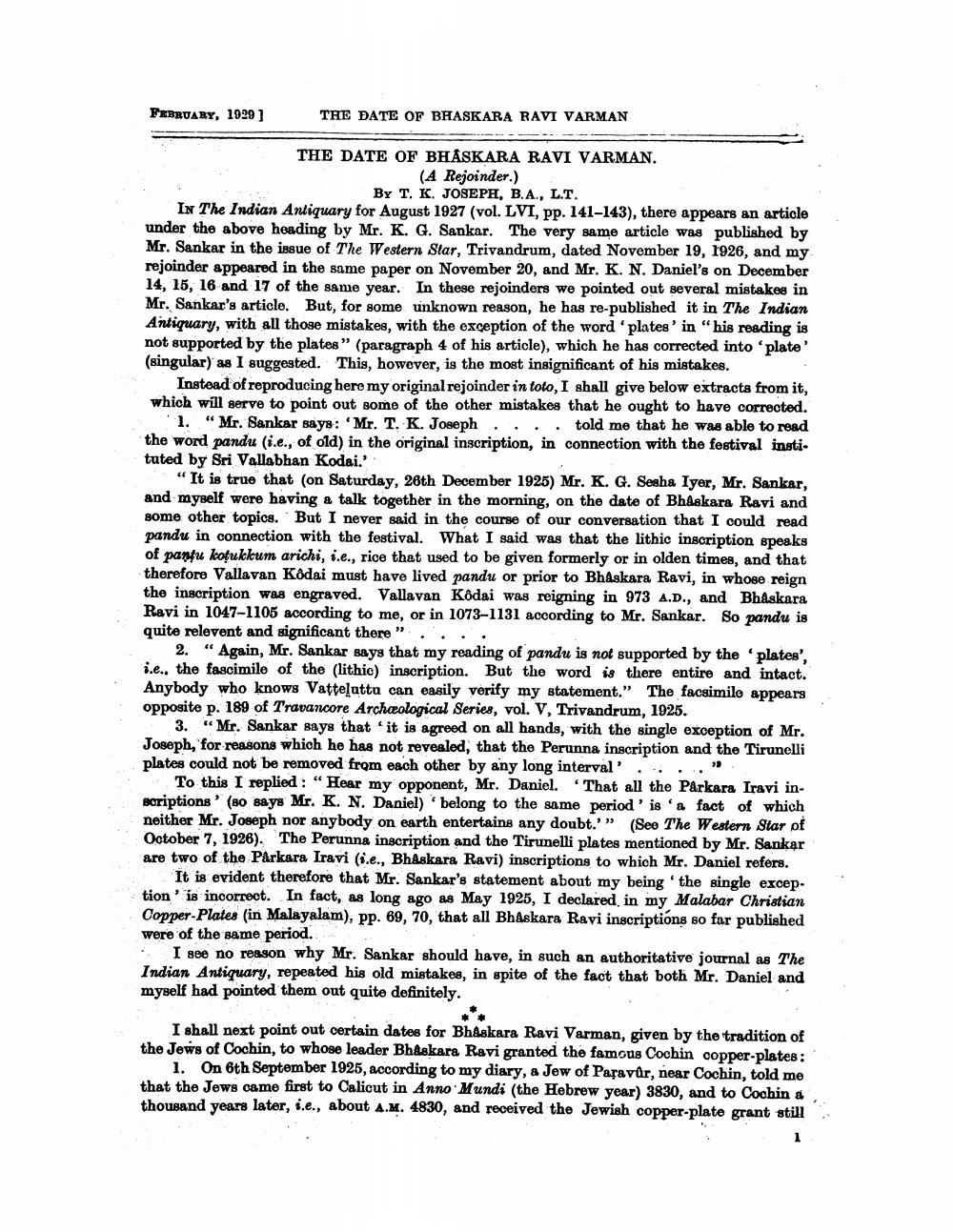________________
FEBRUARY, 1929 ]
THE DATE OF BHASKARA RAVI VARMAN
THE DATE OF BHASKARA RAVI VARMAN.
(A Rejoinder.)
By T. K. JOSEPH, B.A., L.T. In The Indian Antiquary for August 1927 (vol. LVI, pp. 141–143), there appears an article under the above heading by Mr. K. G. Sankar. The very same article was published by Mr. Sankar in the issue of The Western Star, Trivandrum, dated November 19, 1926, and my rejoinder appeared in the same paper on November 20, and Mr. K. N. Daniel's on December 14, 15, 16 and 17 of the same year. In these rejoinders we pointed out several mistakes in Mr. Sankar's article. But, for some unknown reason, he has re-published it in the Indian Antiquary, with all those mistakes, with the exception of the word 'plates'in “his reading is not supported by the plates” (paragraph 4 of his article), which he has corrected into 'plate' (singular) as I suggested. This, however, is the most insignificant of his mistakes.
Instead of reproducing here my original rejoinder in toto, I shall give below extracts from it, which will serve to point out some of the other mistakes that he ought to have corrected.
1. "Mr. Sankar says: 'Mr. T. K. Joseph .... told me that he was able to read the word pandu (i.e., of old) in the original inscription, in connection with the festival insti. tuted by Sri Vallabhan Kodai.'
"It is true that on Saturday, 26th December 1925) Mr. K. G. Sesha Iyer, Mr. Sankar, and myself were having a talk together in the morning, on the date of Bhaskara Ravi and some other topics. But I never said in the course of our conversation that I could read pandu in connection with the festival. What I said was that the lithic inscription speaks of pantu kotukkeum arichi, i.e., rice that used to be given formerly or in olden times, and that therefore Vallavan Kôdai must have lived pandu or prior to Bhaskara Ravi, in whose reign the inscription was engraved. Vallavan Kodai was reigning in 973 A.D., and Bhaskara Ravi in 1047-1105 according to me, or in 1073-1131 according to Mr. Sankar. So pandu is quite relevent and significant there" ....
2. "Again, Mr. Sankar says that my reading of pandu is not supported by the 'plates'. i.e., the fascimile of the (lithic) inscription. But the word is there entire and intact. Anybody who knows Vatteluttu can easily verify my statement." The facsimile appears opposite p. 189 of Travancore Archeological Series, vol. V, Trivandrum, 1925.
3. "Mr. Sankar says that it is agreed on all hands, with the single exception of Mr. Joseph, for reasons which he has not revealed, that the Perunna inscription and the Tirunelli plates could not be removed from each other by any long interval' ...
To this I replied: "Hear my opponent, Mr. Daniel. That all the Parkara Iravi inscriptions (80 says Mr. K. N. Daniel) belong to the same period' is 'a fact of which neither Mr. Joseph nor anybody on earth entertains any doubt.'" (Seo The Western Star of October 7, 1926). The Perunna inscription and the Tirunelli plates mentioned by Mr. Sankar are two of the Parkara Iravi (i.e., BhAskara Ravi) inscriptions to which Mr. Daniel refers.
It is evident therefore that Mr. Sankar's statement about my being the single exception is incorrect. In fact, as long ago as May 1925, I declared in my Malabar Christian Copper-Plates (in Malayalam), pp. 69, 70, that all Bhaskara Ravi inscriptions so far published were of the same period.
I see no reason why Mr. Sankar should have, in such an authoritative journal as The Indian Antiquary, repeated his old mistakes, in spite of the fact that both Mr. Daniel and myself had pointed them out quite definitely.
I shall next point out certain dates for BhAskara Ravi Varman, given by the tradition of the Jews of Cochin, to whose leader Bhaskara Ravi granted the famous Cochin copper-plates:
1. On 6th September 1925, according to my diary, a Jew of Paravûr, near Cochin, told me that the Jews came first to Calicut in Anno Mundi (the Hebrew year) 3830, and to Cochina thousand years later, i.e., about A.M. 4830, and received the Jewish copper-plate grant still




